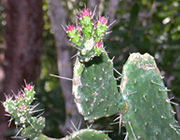Florida semaphore cactus facts for kids
Quick facts for kids Florida semaphore cactus |
|
|---|---|
 |
|
| Conservation status | |
| Scientific classification | |
| Genus: |
Consolea
|
| Species: |
corallicola
|
| Synonyms | |
|
Opuntia corallicola |
|
The Consolea corallicola is a special type of cactus often called the Florida semaphore cactus or semaphore pricklypear. It only grows in Florida, USA, specifically in the beautiful Florida Keys. This makes it a unique plant found nowhere else in the world! Its common name comes from how it looks a bit like old railway semaphore signals.
Contents
What is the Florida Semaphore Cactus?
This amazing cactus can grow quite tall, like a small tree, reaching up to 8 feet (2.4 meters) high. Its stem parts can be up to 40 centimeters long. These stems are covered in many pink spines. Some of these spines can be longer than 12 centimeters! The biggest spines are found on the main trunk and point downwards.
The flowers of this cactus have a unique smell, a bit like rotting meat. They have fleshy outer parts and red inner parts that are about 2.5 centimeters long. You can see this cactus flowering all year, but it blooms most from December to April. This cactus grows in groups, forming "colonies" with a main plant and smaller "pups" growing around it.
Where Does This Cactus Live?
This cactus lives in very specific places in the Florida Keys. It grows on bare rock with thin patches of humus (rich soil from decayed plants). You can find it in hardwood hammocks or where hammocks meet mangrove areas. The ground is made of Key Largo limestone covered with sand. These areas are usually very close to sea level.
Why Is This Cactus So Rare?
The Florida semaphore cactus is extremely rare. It is considered "critically endangered," which means it's very close to disappearing forever. It might even be the most endangered plant in the United States! It used to grow on more islands, like Big Pine Key, where it was first found in 1919. But now, it's gone from many of those places.
Today, there are only two main groups of these cacti left in the wild. One group is on Little Torch Key and the other is on Swan Key. There's also a small patch of plants on North Key Largo, which grew from pieces that were planted there.
Reproduction and Small Populations
Because this cactus grows in colonies, what looks like many plants might actually be parts of just one genetic individual. This means the total number of truly different plants is very small. Sometimes, a whole group might have fewer than five individual plants.
One of the groups of these cacti is made up only of male plants. This means they cannot reproduce sexually by making seeds. They can only grow new plants from pieces of themselves. In total, there are fewer than 20 distinct individual cacti left in the wild today.
What Threats Does It Face?
The biggest danger to the Florida semaphore cactus right now is a type of moth called Cactoblastis cactorum. This moth is an invasive insect that eats cacti. It's not from Florida and causes a lot of damage.
Other threats include strong storms like hurricanes and sea-level rise. Since the cactus lives so close to the ocean, rising sea levels can harm its habitat. As mentioned, it also has trouble reproducing because some populations are all male. The cactus is also suffering from a type of rot disease. Other problems include tiny bugs called scale insects, poaching (people illegally taking plants), and its habitat being destroyed or damaged.
See also
 In Spanish: Consolea corallicola para niños
In Spanish: Consolea corallicola para niños


